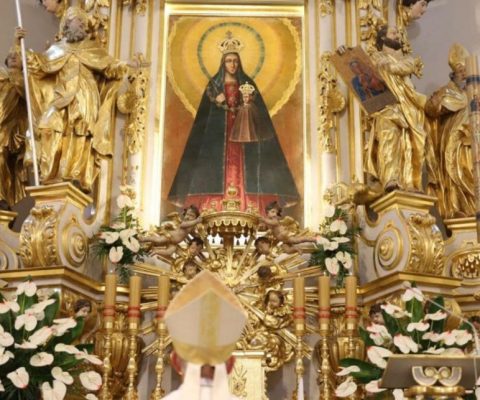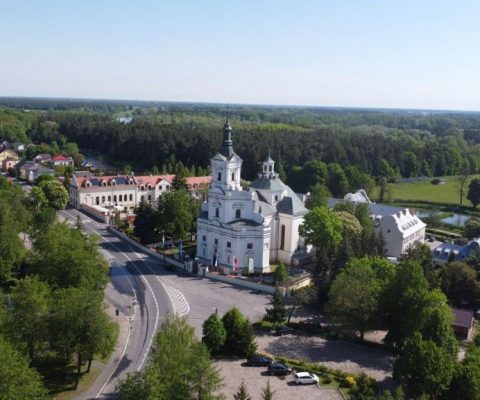Do the origins of Our Lady of Koden go back to the time of St. Luke the Evangelist? How did an immoral act by a Polish nobleman contribute to bringing the image of the Mother of God of Koden from Rome to Poland? The Church-wide jubilee of the 300th anniversary of the miraculous image’s coronation with papal crowns took place 13-15 August 2023.

Image of Our Lady of Kodeń, photo archive of the Missionary Oblates of Mary Immaculate
The history of the Icon of Our Lady of Koden dates back to apostolic times
According to ancient legends, St. Luke the Evangelist is said to have painted an image of Holy Mary on a board of a table from the House of Nazareth. He was also said to have carved Her statue, which was taken to Constantinople. There she was seen by a Benedictine monk named Gregory, who in 590 became the Pope known today as Gregory I the Great.
As the head of the Church, he did not forget the statue he had seen years before and decided to bring it to Rome. The image was named, after the Pope, the Gregorian Madonna, and the image installed today in the high altar in Koden is a painted copy of that statue of Pope Gregory.
Why is Our Lady of Koden also called Our Lady of Guadalupe?
Once upon a time, Bishop Leander of Seville was said to have come to Pope Gregory. He is said to have asked the Holy Father to transfer the miraculous statue to the Benedictine Abbey in the town of Guadalupe, Spain.
This was done, and that is why today Our Lady of Koden is also called Our Lady of Guadalupe. Of course, this does not refer to the famous shrine in Mexico, but to the Spanish town of the same name.
The author of the painted copy of the statue of Our Lady, which can be admired today in Koden, was the Discalced Carmelite nun Sister Bernarda. However, there is also another version of the statute’s story.
According to other sources, the image of Koden was painted by Archbishop Augustine of Canterbury at the request of Pope Gregory and was patterned on the sculpture in his private chapel. The Pope commissioned a copy as he found it difficult to part with the sculpture donated to Spain, and the painting reminded him of it.
The image of Mary painted by Archbishop Augustine is said to have remained in Rome until the 17th century. Some suggest that the Koden painting is rather a copy of the one made at the request of Gregory the Great. This is indicated by its technique and the use of oil paints, which casts doubt on the claim quoted above.
How Prince Sapieha stole the painting of Our Lady of Koden from the Pope
In the 17th century, the fate of the painting was linked to the figure of Prince Mikołaj Sapieha, nicknamed as the Pious, the then owner in Koden. On one occasion, he became paralysed. At the urging of his wife, he went on a pilgrimage to Rome, although he remained in a reclining position during the journey. Thanks to the support of his companions, he reached his destination and was to be completely healed during the Mass celebrated in the private chapel of Pope Urban VIII. This changed his life.
He asked the Holy Father for a miraculous image to take to the ancestral church under construction in Koden. To Sapieha’s despair, the Pope refused. Out of love for the Mother of God, however, the nobleman decided to steal the miraculous image with the help of a bribed sacristan.
Sapieha reached Koden and had the image temporarily placed in the castle Chapel of the Holy Spirit, and later in the new church. The Pope excommunicated Sapieha, so, among other things, he could not receive the sacraments or enter any church. However, the cunning nobleman decided to circumvent this ban and asked for rooms and a special balcony to be added, which allowed him to listen to services without formally entering the church.
In the 1730s, Sapieha went on a penitential pilgrimage to ask for the removal of the ban and was successful. The Pole’s commitment to defending the Catholic Church and the intercession of the apostolic nuncio in Poland were said to have been decisive.
The Pope eventually gave the painting to Sapiecha, which is confirmed by a copy of the document found in Koden. The theft of the painting is the subject of Zofia Kossak’s novel Blessed Guilt.
The image of Our Lady of Koden: new papal crowns after 300 centuries
Our Lady of Koden was crowned with papal crowns in 1723 at the request of Jan Fryderyk Sapieha. The coronation in Koden was the third one in the then Republic, after the shrine of Jasna Góra (1717) and Trakai n. Vilnius (1718).
The image of Our Lady of Koden returns to town in 1927
During the period of the partitions of Poland, the Tsarist invaders seized the miraculous painting from Koden and moved it to Jasna Góra, where it spent 52 years in the Chapel of the Heart of Jesus. On its way back to Koden, it stayed for some time in Warsaw Cathedral, the chapel of the Royal Castle, and in Siedlce.
The painting was returned to Koden in 1927. The celebrations were attended, among others, by the then Archbishop Adam Sapieha of Krakow, a descendant of the Sapieha family from Koden. The prominent figures who have visited the Kode Shrine include Cardinal Karol Wojtyła, later Pope John Paul II, and Cardinal Primate of Poland Stefan Wyszyński.
Celebrations of the 300th anniversary of the coronation of the image of Our Lady of Koden
On 13-15 August 2023, Koden was the site of jubilee celebrations marking the 300th anniversary of the coronation of the image with papal crowns. The celebrations has a universal character and was attended by the papal envoy. The event took place under the patronage of President of the Republic of Poland Andrzej Duda.
More information about the celebrations can be found at the website of the shrine: koden.com.pl.
Photo archive of the Missionary Oblates of Mary Immaculate

